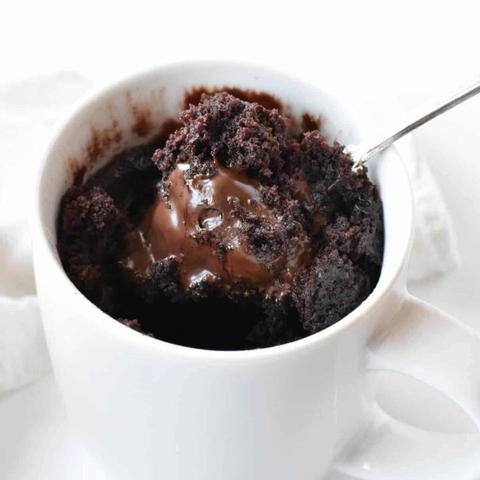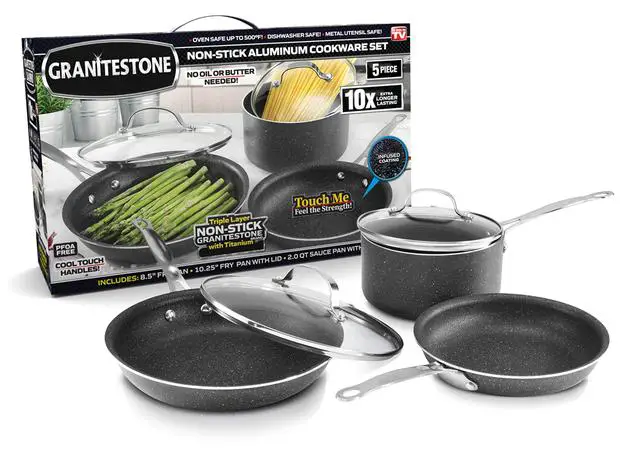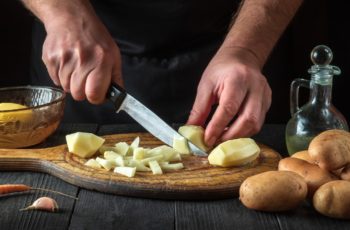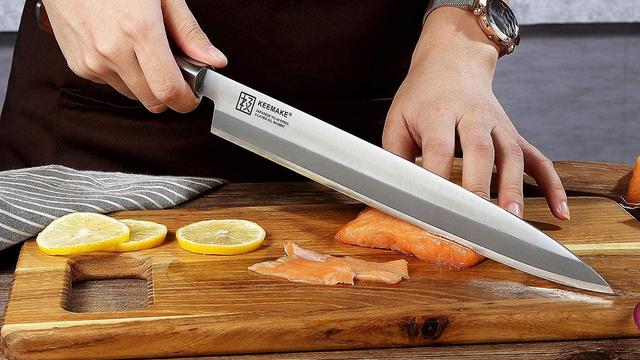
“Discover the Ultimate Sushi Knife: Unleash your inner sushi chef with our top-rated selection of the best sushi knives. Crafted from premium materials, these precision blades ensure effortless slicing and clean cuts for an unmatched culinary experience. Elevate your sushi-making skills today!”
Best Sushi Knives for Making Sushi at Home

Making sushi at home requires dedication and skill, but with the right tools, you can create beautiful and delicious rolls. While a proper sushi knife is not necessary for slicing raw fish, it is essential for creating presentation-worthy nigiri. Most of the best sushi knives are made in Japan, but you can also find Western-style options.
When choosing a sushi knife, it’s important to invest in a high-quality one that will last a long time. Look for knives made from one piece of steel (Honyaki) or two pieces (Kasumi). Single-piece steel blades are preferred in high-quality knives but come with a higher price tag.
The Japanese-style Yanagi ba knife is recommended for cutting fish and sushi. It is a universal knife used by professional chefs and provides precise cuts. Other types of knives that make up a sushi knife set include Usuba knives for cutting and peeling vegetables, and Deba knives for heavy-duty tasks like cutting through bones.
When selecting a sushi knife, consider factors such as blade material, handle design, and brand reputation. Avoid cheap options as they may not be worth the investment.
To properly care for your sushi knife, avoid tossing it into the sink and hand wash and dry it immediately after use. Keeping the blade sharp is crucial to achieving clean slices of fish or cutting through sushi rolls without damaging them.
What Sushi Knives Do I Need?
Making sushi at home requires skill and precision, and having the right knives can greatly enhance your sushi-making experience. While it is not necessary to have a full set of expensive sushi knives, there are a few essential ones that every aspiring sushi chef should consider.
The first and most important knife is the Yanagi ba knife, also known as the sushi knife. This long and thin knife with a single-sided edge is perfect for slicing raw fish in one smooth motion. Its sharpness allows for incredibly thin cuts, making it ideal for creating nigiri and sashimi.
The Usuba knife is another useful tool for making sushi at home. This single-edge flat knife is designed for cutting and peeling vegetables and garnishes. It excels at chopping and slicing, which are essential techniques in vegetable preparation for sushi.
If you plan on preparing the whole fish yourself, a Deba knife may come in handy. This heavy-duty knife can be used to cut through bones and can serve as a substitute for a meat cleaver. However, it is not necessary unless you frequently work with whole fish.
When selecting sushi knives, look for ones made from high-quality steel that will last a long time. It is worth investing in knives made from one piece of steel (Honyaki), as they tend to be of higher quality than those made from two pieces (Kasumi). Additionally, choose knives from reputable brands that are well-respected in the market to ensure you are getting a reliable product.
Yanagi Ba
A Yanagi ba knife is a traditional Japanese sushi knife used by chefs to cut fish and sushi. It is long and thin, with a one-sided edge, a sharp tip, and a slightly concave back to prevent food from sticking to the blade. Made of high carbon steel, it is important to take good care of the knife to prevent rust or damage. When using a Yanagi ba knife, you slice the fish with a pulling motion, creating thin and precise cuts due to the sharpness of the blade.
The Usuba knife is a single-edge flat knife used for cutting and peeling vegetables and garnishes in sushi preparation. It excels at chopping and slicing techniques and is often used by chefs when preparing vegetables for sushi. The Usuba knife has a single bevel, so it’s important to choose a left-handed version if you’re left-handed. Keeping this knife sharp ensures easy slicing through ingredients.
The Deba knife is ideal for heavy-duty tasks like cutting through bones, making it useful when preparing whole fish. However, unless you plan on preparing the entire fish yourself or replacing all your Western-style knives with Japanese ones, the Deba knife may not be necessary for home sushi-making. It has weight but is not overly heavy, providing good handling and balance.
Usuba
A Usuba knife is a single-edge flat knife that is used to cut and peel vegetables and garnishes. They are particularly good at chopping or slicing, which are the cutting techniques most used in the preparation of vegetables for sushi. The Usuba knife is a single-bevel knife, meaning it has a flat side and a beveled side, so make sure to get a left-handed version if you’re left-handed.
The Usuba knife is exceptionally easy to slice through your sushi with when it is kept sharp. It provides clean and precise cuts, making it perfect for creating beautiful vegetable garnishes and artistic presentations. The blade of the Usuba knife should be made from high-quality steel to ensure durability and long-lasting sharpness.
Deba
A Deba knife is a versatile tool that can be used for heavy-duty jobs like cutting through bones. However, unless you plan on preparing the whole fish yourself, you may not need this knife for making sushi at home. The Deba knife can also be used as a substitute for a meat cleaver if you’re looking to replace your Western-style knives with Japanese-style ones. It has a weighty feel to it, but it’s not overly heavy, making it comfortable to use.
When choosing a sushi knife set, it’s important to prioritize the Yanagi ba knife as it is the most essential tool for making great sushi and sashimi at home. Look for a knife that uses a single piece of steel for the blade, has a D-shape handle for stability and comfort, and is from one of the best sushi knife brands. While there are many brands claiming to make high-quality Japanese knives, it’s advisable to choose a tested and respected brand in the market.
Proper care and maintenance of your sushi knife are crucial to ensure its longevity and performance. Avoid tossing the knife into the sink as this can cause chipping. Instead, hand wash and dry your knife immediately after use. Keeping the blade as sharp as possible is key to achieving beautiful slices of fish for sashimi or sushi.
How to Find the Best Sushi Knives
To find the best sushi knives, there are a few key factors to consider. First, determine your budget and be willing to invest in a high-quality knife that will last. While you don’t necessarily need the most expensive knife, it’s important to prioritize quality.
Next, look for knives made from one piece of steel, known as Honyaki, or two pieces of steel, known as Kasumi. Single-piece steel blades are preferred for their superior quality, but they often come with a higher price tag.
Consider the type of sushi knife you need. The Yanagi ba knife is a traditional Japanese sushi knife used by chefs and is great for cutting fish and making sushi rolls. If you want to go all out, there are other types of knives that make up a sushi knife set.
When shopping for sushi knives, be cautious of low-priced options that may not offer the same level of quality or durability. It’s worth investing in a reputable brand that is tested and respected in the market.
Once you’ve found the best sushi knife, it’s essential to take proper care of it. Avoid tossing the knife into the sink, as this can cause damage. Instead, hand wash and dry the knife immediately after use to maintain its sharpness and prevent rust.
Overall, finding the best sushi knives requires careful consideration of budget, blade construction, type of knife needed, and brand reputation. By prioritizing quality and taking proper care of your knives, you can enhance your sushi-making skills at home.
Upkeep for your Sushi Knife
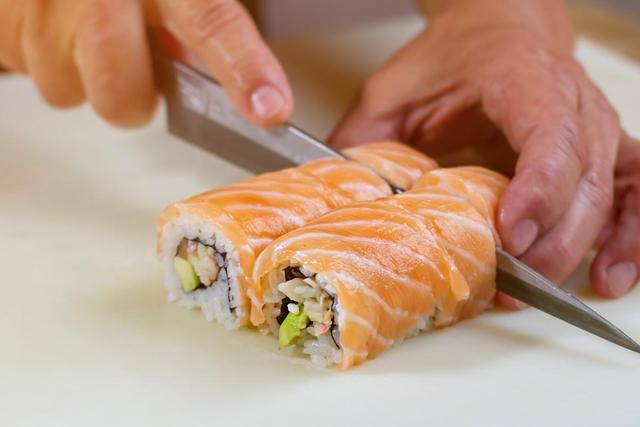
Proper upkeep and care of your sushi knife is crucial to ensure its longevity and performance. Here are some tips on how to maintain your sushi knife:
1. Hand wash: Always hand wash your sushi knife with warm water and mild dish soap immediately after use. Avoid soaking the knife in water or putting it in the dishwasher, as this can cause damage.
2. Dry thoroughly: After washing, make sure to thoroughly dry the knife with a clean cloth or towel. Moisture can lead to rusting and dulling of the blade.
3. Store properly: Store your sushi knife in a safe and dry place. Consider using a knife sheath or blade guard to protect the edge from accidental damage.
4. Sharpen regularly: Keep your sushi knife sharp by regularly honing and sharpening the blade. You can use a whetstone or sharpening rod specifically designed for Japanese knives.
5. Avoid cutting hard surfaces: Use your sushi knife only on soft cutting boards or surfaces made of wood or plastic. Cutting on hard surfaces like glass or ceramic can damage the blade.
6. Handle with care: Treat your sushi knife with respect and handle it carefully. Avoid dropping, twisting, or using excessive force when using the knife.
By following these maintenance tips, you can keep your sushi knife in optimal condition for many years of enjoyable sushi-making at home.
How to Slice Fish for Sushi and Sashimi
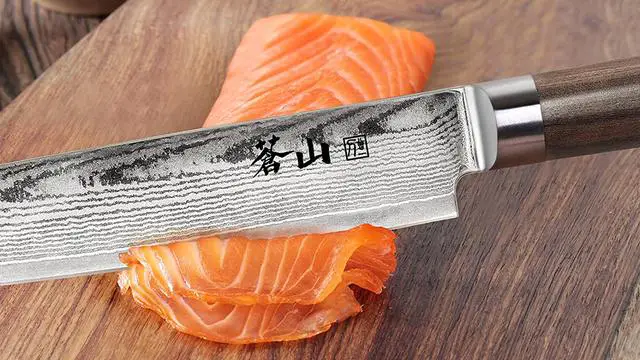
Slicing fish for sushi and sashimi requires precision and technique. Here are some steps to help you achieve beautiful slices:
1. Start with a sharp sushi knife: Before slicing, make sure your sushi knife is properly sharpened. A dull knife can damage the fish and make it difficult to achieve clean cuts.
2. Square up the fish: If the piece of fish you’re using is not pre-cut, square it up to about the width of four fingers. This will ensure even slices.
3. Angle your knife: Hold the sushi knife at a 45-degree angle when slicing. This helps create thin, delicate slices.
4. Use a pulling motion: Place the heel of your blade on the fish and pull the knife towards you in one fluid motion. Avoid pushing the knife forward, as this can crush the fish.
5. Adjust slice thickness: The size of your slices will depend on whether you’re making nigiri or sashimi. Generally, sashimi slices are thicker than nigiri slices.
6. Practice makes perfect: Slicing fish for sushi and sashimi takes practice, so don’t get discouraged if your first attempts aren’t perfect. With time and experience, you’ll become more skilled at achieving consistent, beautiful slices.
Cutting Sushi Rolls
When it comes to cutting sushi rolls, using a regular kitchen knife can be challenging and may result in squished ingredients or torn nori wrappers. This is where a good sushi knife comes in handy. Before you start cutting, make sure to hone the blade of your sushi knife to ensure it’s at its sharpest. You can do this by putting a little water or rice vinegar on the blade, which will prevent it from sticking to the rice.
To cut through the roll, position the butt of the knife against the roll and slowly pull it towards you in one long slice. This pulling motion helps maintain the shape and presentation of the roll. Another technique used by sushi chefs is to tightly wrap the roll in plastic wrap before cutting. This ensures that the roll stays intact and looks nice even after slicing.
Properly caring for your sushi knife is crucial for its longevity. After using it, never toss it into the sink as this could cause it to chip. Instead, hand wash and dry your knife right away to prevent rusting or damage.
Conclusion
Making sushi at home can be a rewarding and enjoyable experience, but it does require some dedication and skill. While a proper sushi knife is not always necessary for making good sushi rolls, it is essential for creating beautiful nigiri. When choosing a sushi knife, it is important to look for high-quality options made from one piece of steel, known as Honyaki. Investing in a good sushi knife will ensure that it lasts a long time and helps you hone your sushi-making skills.
The Yanagi ba knife is the traditional Japanese sushi knife used by chefs and is ideal for cutting fish and sushi. While other knives such as the Usuba and Deba can be useful additions to a sushi knife set, they are not necessary unless you plan on preparing the whole fish yourself or swapping out all of your Western-style knives.
When using a sushi knife, it is important to keep the blade sharp and take proper care of the knife to avoid damage or rusting. Properly slicing fish for sashimi or sushi requires practice and precision, but with the right technique and tools, you can create beautiful slices. Additionally, using a sharp sushi knife makes cutting through sushi rolls much easier without damaging the nori wrapper or squishing the ingredients inside.
If you choose to add a sushi-specific knife to your kitchen tool kit, make sure to properly care for it by hand washing and drying it immediately after use. With proper care and usage, a high-quality sushi knife will serve you well for many years to come.
In conclusion, finding the best sushi knife is crucial for achieving precision and excellence in Japanese cuisine. A high-quality, sharp and well-balanced knife can enhance the chef’s skills, ensure clean cuts, and elevate the overall dining experience. Whether a professional chef or an amateur enthusiast, investing in a top-notch sushi knife will undoubtedly enhance the art of sushi making.
https://www.youtube.com/watch?v=P4jfHUxOT50&pp=ygUQYmVzdCBzdXNoaSBrbmlmZQ%3D%3D
Learn More About Grilling
If you want to learn more about grilling, check out these other helpful resources!



